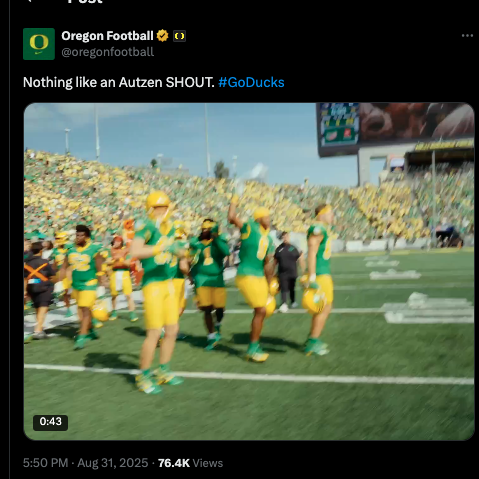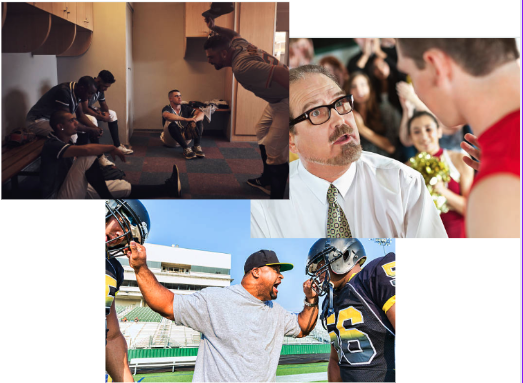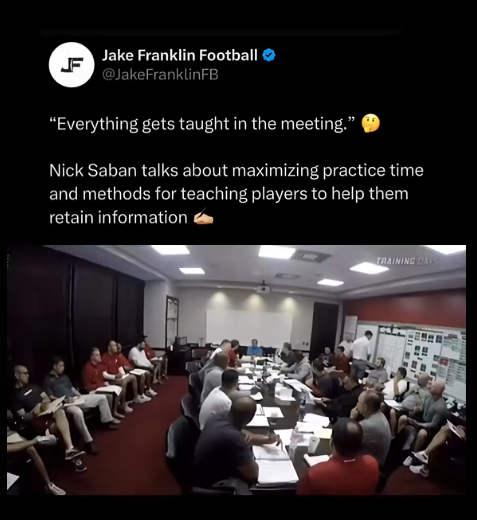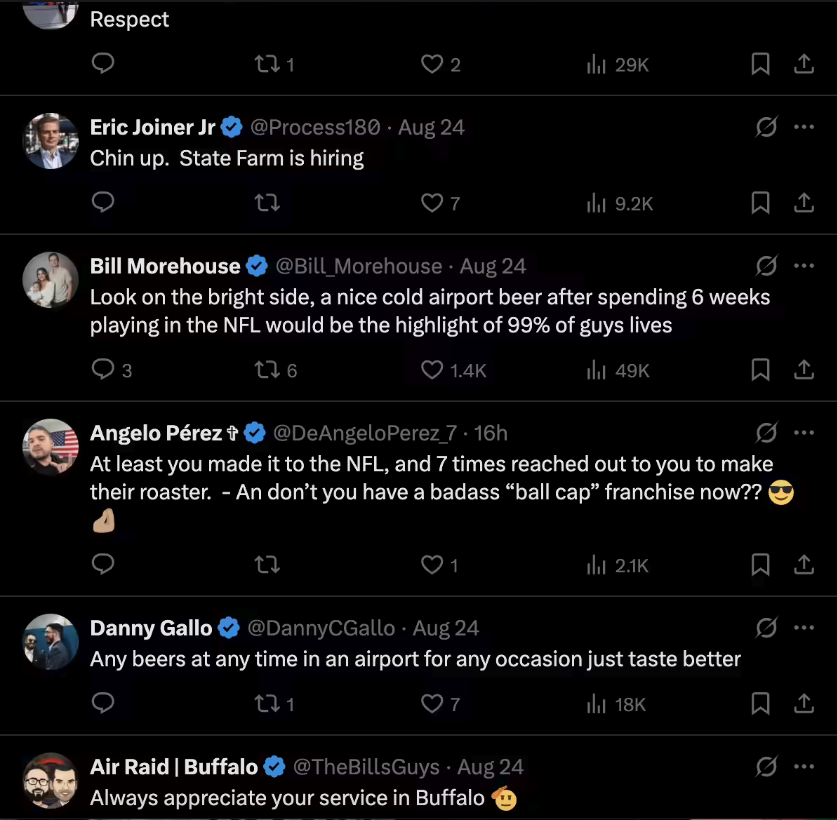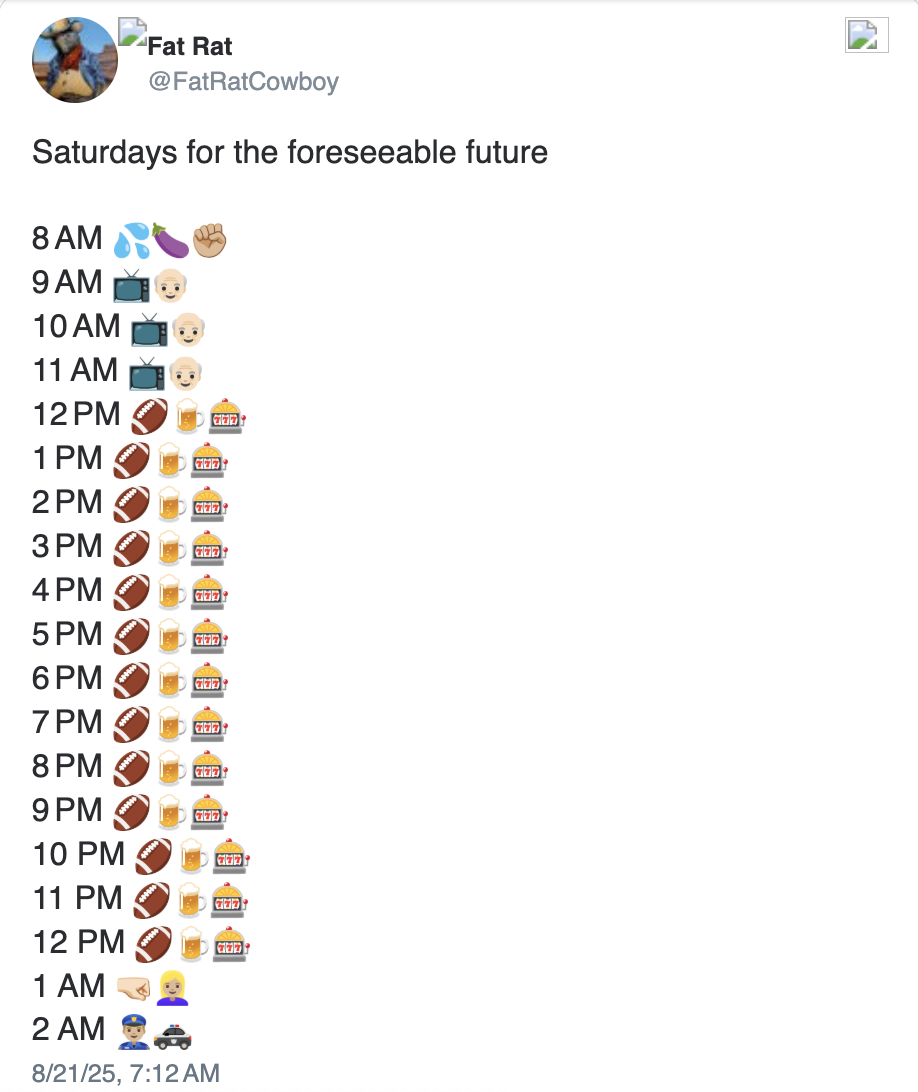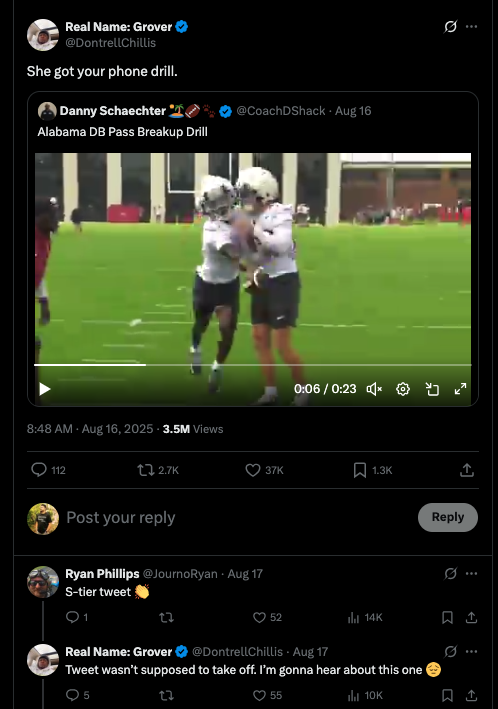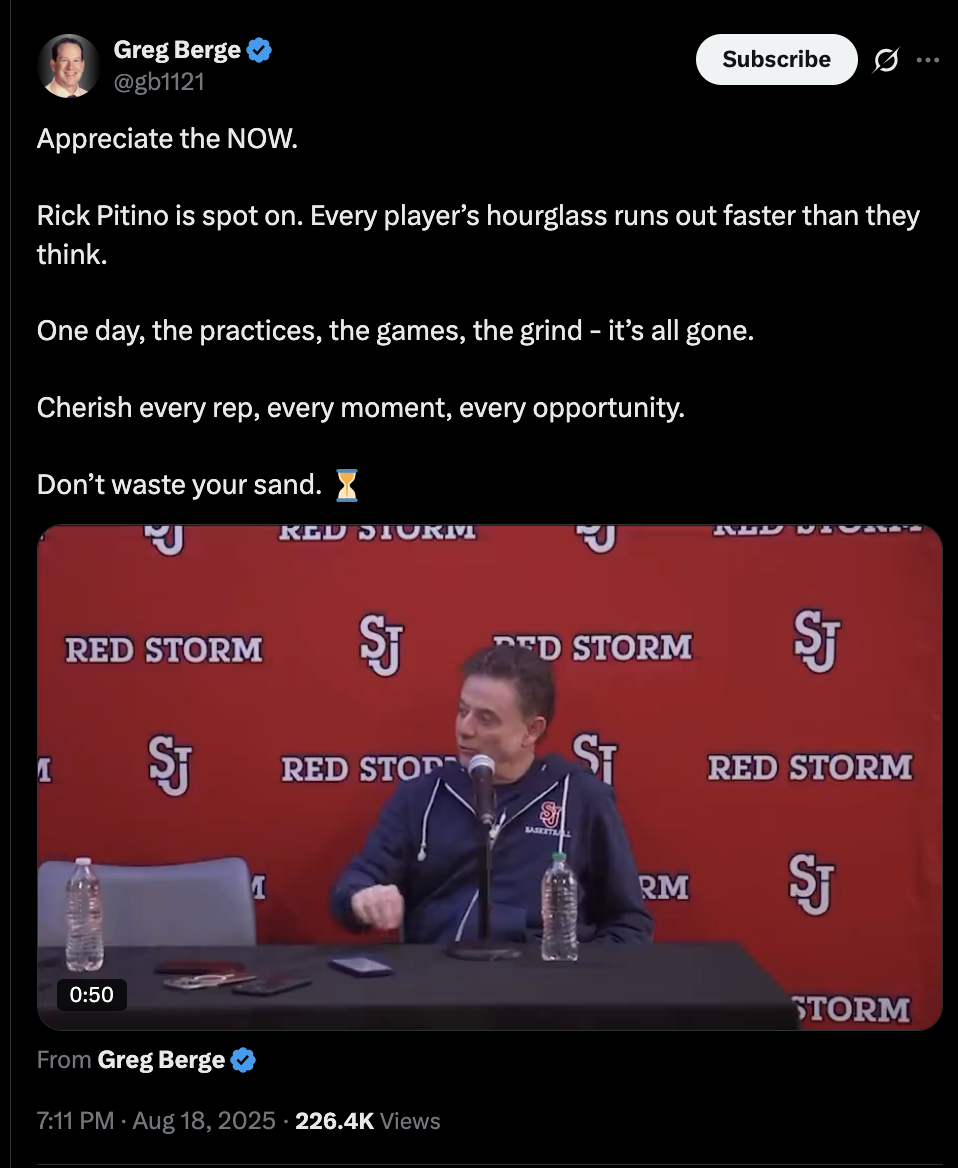From Spark to Accountability: What Coaches Can Learn from GBV Experts
“What’s the best way to summarize two days surrounded by experts, energy, and activation toward the change I believe in?”
That was the struggle I wrestled with on the plane ride home from Ontario, Canada yesterday, after presenting at Interval House Hamilton’s Rewriting the Playbook Summit on GBV prevention in sport.
If I share my notes, the information spreads—but do the speakers get proper credit? If I don’t share them, the insights die in my Google Drive. Where’s the sweet spot between community, learning, and giving credit where it’s due?
Here’s where I landed: below is a list of speakers, their online profiles, the topic of their talk, and my #1 takeaway from each. Not perfect, but it’s my attempt at keeping the learning alive and the credit intact. (Message me directly if you’d like access to my full notes.)
Sue Taylor (Executive Director) & Jennifer Rowan (Dir. of Communications & Development) – Interval House Hamilton
Interval House Hamilton
Pulled together a 115-person summit in under 4 weeks and delivered a top-tier event. (Sue: “Welcome to the Chaos Train.”)Courtney Stephen – From Training to Transformation
Website
Takeaway: S.E.E. acronym for building leaders—Spark, Equip, Engage.MPP Jess Dixon – Change Makers: Where Politics Meets Purpose
Website
Takeaway: “Your anger can be your fuel, but it can’t be your content.”Jesse Mahler – Coaching Boys Into Men
Program info
Takeaway: Examine your actions and beliefs—are they supporting a meaningful life, or inhibiting one?Neil Shyminksy – MythBusting
Instagram
Takeaway: The manosphere’s draw is “coolness”—and we need to disrupt the coolness.Soon-to-be Dr. Maddie Brockbank – Stories, Strategies and Impact
LinkedIn
Takeaway: The power of pairing an accountability approach with an invitation approach in GBV education.
Coach Prompt
Which of these six takeaways could fit into your own staff or player meetings this season—and what’s stopping you from making space for it?
Player Prompt
If you could add one conversation topic to your team meetings that goes beyond X’s and O’s, what would it be?
Coaches: Can Your Players Tell the Difference Between “Not That Deep” and Real Harm?
I want to give credit to Shenikka Moore-Clark, who posted the Instagram carousel linked above and here. When I first came across it, I was struck by the similarities to a lesson we ran with my boys varsity basketball team this past summer on Hurt vs. Harm vs. Abuse. That session was powerful—we asked young men to identify the differences between those three and where in their sports, academic, and personal lives they might encounter them.
Moore-Clark (@the.healingvibe) hits on something even more likely to show up in young men’s daily lives in 2025: words matter. And fluency with words is something players need just as much as fluency with any skill on the court.
I won’t steal her entire post here (it’s absolutely worth a full dive for you and your staff), but think about the potential of your guys being equipped to respond clearly and correctly to things said to them—or about them. How many times have you found yourself refereeing disputes between players only to hear, “It wasn’t that big a deal,” or “It’s not that deep”?
What if your players could accurately examine the words thrown their way, name the difference between harmless, hurtful, or harmful, and then choose the right response? That’s growth. That’s emotional fluency. And that’s a team less likely to implode from the inside out.
Coach Prompts
How often do you intentionally teach your players to unpack the meaning and impact of the words they use?
When disputes break out, do you help your athletes distinguish between hurt feelings and genuine harm?
What systems or lessons could you introduce this season to build fluency in “words matter”?
Player Prompts
Have you ever brushed something off with “it’s not that deep” when it actually was?
What’s the difference between being hurt by words and being harmed by them?
How would your team be different if you all learned how to tell the difference?
When “Focus on the Game” Becomes Denial
Tyreek Hill, star wide receiver for the Dolphins, has been publicly accused by his ex-wife of domestic violence on multiple occasions. Despite those allegations, when asked, Hill recently said that the focus should remain on football—not on what’s happening off the field. I won’t say I’m shocked. I won’t say I’m surprised. This is what we (the athletics community) do when one of our own is implicated in harm. We pull an ostrich move—stick our heads in the sand—yell “keep the main thing the main thing,” and pretend the game matters more than the lives in our team room or their circles.
This isn’t defending focus. It’s intentional distraction. A purposeful denial of our shared humanity.
I’m not going to debate the usual “we don’t know everything” or “it’s he said / she said” bullshit people hide behind. If you want that conversation, read Credible by Deborah Tuerkheimer; Why Does He Do That by Lundy Bancroft; or Sexual Justice by Alexandra Brodsky. But as a coach, you cannot truly believe that running today’s practice plan to perfection is in the best interest of a player living through this.
What about something as simple as saying, “Go get your shit together”—take care of yourself first—while this plays out, or offering them a leave of absence during the process? Is that too much? Or is it too risky for your wins this weekend? What does your priority really say?
Coach Prompts
If one of your players was accused or going through serious personal trauma, would you know how to shift your practice plan to support them?
What boundaries or precedents do you want your team to follow when off-field issues must be honored in your daily plan?
Do you believe sports culture still allows someone to be punished socially for seeking help? How do you counter that?
Player Prompts
If you were in Tyreek Hill’s position, would you feel safe telling your coach you need space—even if it meant being benched or missing games?
What would it mean, to you, to have a coach say “Your well-being matters more than our game tonight”?
When you hear “focus on football,” do you feel supported—or silenced?
What Coaches Can Learn From a Student Distraction Chart
I’ve always found Edutopia to be both insightful and useful. They’re unafraid to take a different lens on educational settings, and I’ve found their tools translate seamlessly into coaching.
This distraction chart is a great example. Imagine giving your players the ability to actually NAME what’s pulling their focus. Most of them have never been asked to do that.
Nick Winkelman’s The Language of Coaching makes the point that humans are hardwired to mind-wander. Our brains naturally shift attention, and simply yelling “lock in” doesn’t override that wiring.
One of the most effective ways to grab attention is novelty. That’s why something like this—maybe reframed as “Where do your eyes go during a timeout?”—hits different. It’s fresh, it’s memorable, and it puts language to what most players have only felt as a vague distraction.
Instead of demanding focus, we can give our guys tools to redirect it.
Coach Prompts
What’s your current method for helping players recognize when they’ve lost focus?
How do you teach focus instead of just demanding it?
Could a simple tool like a “timeout distraction chart” create more awareness in your team?
Player Prompts
What usually pulls your attention away during practice or games?
How do you bring yourself back when your mind starts to wander?
If you could design your own “focus reset” strategy, what would it look like?
Why Peer Pressure Shapes Masculinity—and How Coaches Can Change the Script
I would love for everyone to both read the caption from the post above and listen to the interview clip it’s attached to. I found myself really leaning into the caption, because it validates why TeamsOfMen work belongs in team rooms. The research shows we cannot assume—even with well-intentioned fathers—that positive masculinity will automatically be shaped at home.
We’ve all seen it: players holding each other to impossible, Manbox-driven standards. We’ve witnessed the vitriol young men can face from teammates if they don’t measure up to those standards.
Dr. Hartman’s framing of loneliness as an existential human fear also hit me hard. Guys in your team room, desperate to belong, will do almost anything to avoid being ostracized. And that means they’ll perform harmful stereotypes of manhood if that’s what it takes to stay “in.”
But here’s the hope: we can flip this axis. Coaches can make spaces open to all, rooted in emotional fluency and curiosity. We can build teams where belonging doesn’t require conformity to the Manbox, but instead celebrates connection, vulnerability, and growth. You still get a connected team—but instead of a culture of perpetration, you create a culture of stigma-breakers.
Coach Prompts
Do your players feel like they have to perform masculinity to belong on your team?
How does your program distinguish between “fitting in” and true belonging?
What practices are you using to ensure your team culture doesn’t punish vulnerability?
Player Prompts
Have you ever gone along with something in the locker room just to avoid being left out?
What’s the difference between fitting in and actually belonging on your team?
When have you felt most accepted for who you are rather than what you can prove?
Tragedy Reminds Us: Gender Violence Will Touch Every Team
I’m always cautious about the timing of responses to tragedy, especially when applying a TeamsOfMen lens. Current events hold tremendous potential to educate and encourage unlearning, but I never want to come across as ambulance chasing.
That said, the horrific murder of Timberwolves star Naz Reid’s sister, Toraya, by her boyfriend Shaquille Green, is another painful example of truths we as coaches, athletes, and men must embrace.
First: No matter the level of play, the sport, or the location, your team will be impacted by gender violence—most often the kind perpetrated by men.
Second: No amount of “winning”—championships, money, accolades—shields us from this harm. Success in sport does not insulate us from the realities of violence.
Third: When men aren’t taught how to process and unpack negative emotions, those feelings almost always spill out on the people closest to them. We know this. Data and history prove this. Our job is to equip young men with better tools to pause, process, reflect, and respond.
Fourth: When tragedy hits close to home—whether to one of our players, or to someone they love—how do we show up? What do we say? What do we text? How do we support without overstepping, while letting them guide what help looks like?
These are not abstract questions. They are urgent. Because silence and avoidance only leave our guys unprepared to face the realities that tragedies like this put on display.
Coach Prompts
When tragedy strikes, how does your program respond? Do you have a plan—or just silence?
What tools are you giving your players to process anger, fear, and disappointment in healthy ways?
Do you talk with your team about gender violence before it hits close to home?
Player Prompts
Who do you turn to when you’re carrying heavy emotions—do you feel safe saying it out loud?
If someone you care about was harmed, what kind of support would you need from your team?
Do you believe your team would show up for you in a moment like this? Why or why not?
Building Muscle to Heal: Why Recovery Deserves Celebration
I’ll be honest — when I first saw that September is National Recovery Month, it was a completely foreign concept to me. Not the idea of healing, but the idea that there’s an entire month dedicated to celebrating it.
But as I started reading about the history and purpose of Recovery Month (NAADAC link), it clicked: not only is this month important, it directly connects to what we should be teaching as coaches of male athletes.
Think about it: no coach in their right mind would send a player back out with a torn ACL. Yet somehow, we still expect people to “play through” depression, anxiety, or addiction.
And here’s the deeper truth — recovery requires an incredible amount of vulnerability and resilience. In order to recover, you first have to admit and embrace what needs healing. Whether that’s substance use, a mental health struggle, or a physical injury, there’s a journey there that’s worthy of support and celebration.
My own lack of awareness about Recovery Month is, in a way, a TeamsOfMen curriculum opening. If you’re a football, soccer, or XC coach in season right now, I’d bet most of your young men haven’t heard of Recovery Month either. But if you ask them about it in a team circle, I guarantee at least a few will immediately connect it to someone in their lives — a family member, a teammate, a friend — who is on the path to recovery. That conversation matters.
And that’s where this month ties directly to our mantra work. Our shirt — “Building Muscle to Heal, Not To Harm” — is the perfect tool to spark this conversation. It’s more than fabric; it’s a visible reminder that healing is strength, not weakness.
👉 Grab yours here: Building Muscle to Heal, Not To Harm Shirt
Wear it this month. Start the discussion. Celebrate recovery.
Coach Prompts
“If we would never send a player back out with a torn ACL, why do we sometimes expect people to ‘play through’ depression, anxiety, or addiction? What does that reveal about how we treat mental health versus physical health?”
“Think of your own recovery routines — stretching, ice baths, sleep. What’s the mental or emotional version of those routines?”
“Why is admitting you need help actually a sign of strength, not weakness?”
Player Prompts
“What does recovery mean to you — physically, mentally, or emotionally?”
“Can you think of a teammate, friend, or family member who showed strength by choosing recovery? What can we learn from them?”
“What is one recovery tool you use now — or could use — to keep yourself in a healthier place?”
Coaching Patterns vs. Coaching Manhood: Which One Are You Modeling?
Today's blog will be less about me writing reax (although I thought last night's Jalen Carter spitting on Dak Prescott incident ESPN link was PERFECT timing with our blog post Thursday TeamsOfMen link) and more a showcase of how to slightly twist professional development that coaches are already comfortable with into TeamsOfMen growth they usually aren’t.
The image above is from a post on X by Kevin DeShazo, who describes himself as a “Speaker and author [who] helps leaders and teams close the gap between their performance and potential. Co-Founder of @bebetterleaders.” This is LESS any sort of criticism of him and more a snapshot of coaches in general.
His post had 47k likes. That’s a solid-sized audience of people who agreed enough to smash the like button. But now ask yourself—what if I posted the reframing below? Would it hit the same way with coaches of male athletes, or would there be more hesitation…maybe even some pushback or disagreement?
Coach Prompt
What daily behaviors of mine are coaching “patterns,” and what daily behaviors are coaching “manhood”? Am I willing to blur that line in front of my guys?
Player Prompt
When you watch your coaches (or older players), what traits do you notice yourself copying—even if they’ve never told you to? Which ones are worth keeping, and which ones are worth unlearning?
Pregame Antics Don’t Build Men—They Expose Coaching Gaps
A couple of things bubbled up for me during this video of Grant Union losing their minds pregame, all under the guise of “we hyped.”
First: did you notice their coach? Just as over the top as his players—jawing at opposing teenagers and the other staff. If that’s not testimony to the power of modeling, and proof that “being the coach” doesn’t guarantee you aren’t coaching to harm, I don’t know what is.
Next: emotional regulation. Grant Union had none. This is another testimony to a lack of focus from a staff on what actually matters. Getting players ready and excited for a big game is one thing. But not equipping them with the tools to modulate how they release that energy? That’s exactly how 17-year-olds cross the line.
Finally: so many comments under the video were stuck on the idea that “yo, Grant got their ass kicked by Folsom, that’s why this pregame nonsense was wrong.” No. Even if they had won, the way they behaved was still bullshit. The result doesn’t excuse the process.
Too many coaches don’t have the tools to help kids develop emotional fluency. So they settle for something like, “Hey, if you’re gonna talk shit, back it up”—and then act shocked when their guys go off the rails. That’s on us as the adults in the room. We set the tone.
And yes, this is exactly why we’ve built lessons for these Meet the Moment situations. Because these moments—how your guys respond, how your staff prepares them—will define your season far more than the scoreboard. DM me for details on how to get those plans.
Coach Prompts
How do you teach your players to channel energy without crossing the line?
Would your team know how to meet the moment without losing control?
What does your pregame model for your players about focus, respect, and emotional control?
Player Prompts
When you get hyped before a game, what helps you stay locked in instead of going over the edge?
How do you want opponents to see you in pregame—confident or out of control?
What’s one way your team could keep its edge without losing its composure?
Would You Let Pornhub Install Your Offense?
Fight The New Drug posted this article (link) today and my TeamsOfMen framing mechanism kicked into high gear.
For context: I first came across FTND late in my college coaching career (see their FAST FACTS) and started using their scripts and info with both my players and my own kids at home (Let’s Talk About Porn activity). I found their material digestible, ACCURATE, and written in a way that actually resonates with young men.
Fast forward to today’s article—I decided to decode the lengthy piece and present it in both the graph at the end of this writing and in the following words:
You’re a coach of a 100-man football roster or a 30-man basketball program. Let’s apply the percentages and stats directly to your locker room:
32 of your guys are INTENTIONALLY using porn every day.
8 of your guys are treating Pornhub like their PROFESSOR on sexual experiences.
33 of your players got sexts last night, and 20 of them sent sexts back.
50 of your guys went on a “slutpage” last night (or your entire JV roster of 15 did).
You don’t think that AFFECTS the climate and culture of your team—the words they use, the things they listen to, the way they interact with women on campus? Of course it does.
Even worse, coach, let me reframe it:
What if I told you 25 of your football players sat through a 30-minute lecture on your 3rd-down blitz package that installed THE WRONG sequence and keys?
Or that 10 of your basketball players were intentionally watching videos after practice that taught them the WRONG read in ball screen offense?
You’d lose your mind—because you know that means they won’t execute in games. So why are we settling for the WRONG teachers influencing the WRONG reads for our guys in their intimate relationships?
Coach Prompts
How would I respond if a third of my players were learning the WRONG scheme in practice?
Do I apply the same urgency to correcting harmful “lessons” my players are learning about relationships and intimacy?
Where in my program can I insert short but intentional conversations to combat this influence?
Player Prompts
Who are the “teachers” shaping the way I think about sex and relationships right now?
If I found out my basketball playbook was wrong, I’d fix it—so why am I okay with getting the wrong information about intimacy?
How does what I watch, share, or joke about in the locker room affect the way I treat people on campus?
If You Preach Courage, Can You Model It?
I came across this clip the other day on TikTok and it cemented a couple of things for me.
First: I can’t imagine the podcast without Dr. Marc Lamont Hill. He has leveled up the conversations, challenged the thinking on the show in ways no one could have predicted, and is really the only reason I still tune in.
Second: I wonder how his question lands with coaches. If I reframed it to: “What flag are you willing to plant in the ground—what issue are you willing to be fired for?” —would I get more answers like his cohosts, or like Marc’s?
Every coach in America parrots the cliché: “You take the job knowing you’ll be fired one day.” But then we make decisions rooted in fear of being fired—whether it’s scheme choices, player personnel, or, most importantly, staying silent on things that actually matter. We “play it safe,” we “don’t rock the boat,” because employment feels more important than integrity.
And yet, this runs in direct contradiction to the mantras we feed our teams: play with courage, persevere through adversity, stand strong under pressure.
Being fired is awful (I know, I’ve lived it). But once you’ve gone through it and come out the other side, the freedom it brings—to act fully aligned with your convictions—is immense.
If we can’t model what it looks like to take a stand knowing there’s risk attached, how can we ever expect our players to?
Coach Prompts
What issue or principle would you be willing to lose your job for? Do you know your answer right now?
Are your day-to-day coaching decisions guided more by conviction or by fear of consequences?
How do you model courage for your players outside of game situations?
Player Prompts
Think of a time you stayed silent when you should’ve spoken up—what stopped you?
Who on your team has shown courage recently, even at personal risk? How did that impact you?
If your coach asks you to “play with courage,” what does that actually mean to you?
Fun Isn’t a Distraction—It’s a Weapon: Lessons From Oregon’s “Shout” Tradition
I went to State College, PA this past weekend to watch my brother’s Nevada team take on Penn State. I met up with a group of long-time friends (we’ve known each other since junior high), drove over, and spent the weekend together.
I set that stage not just because Penn State tried playing Shout in the first quarter—and I laughed at their attempt compared to Autzen’s tradition—but also because of the concept of JOY.
My friends and I had fun together. We laughed. We debated. We argued silly topics through serious worldviews. We hugged. We talked. It was revitalizing—not just for our friendship, but as proof that there is community for men. We just have to make space for it.
That’s why the Oregon clip (linked here: Oregon Football “Shout” clip) hit me. The staff at Oregon isn’t shutting down their guys’ joy in dancing and singing. And remember—this is the FOURTH QUARTER.
Most places aren’t letting their guys dance and sing. They’re throwing up 4s and screaming “lock in.” Yes, Oregon was up 40 on an FCS opponent here, but I’ve seen them do the same when down 6 to Boise State, tied with Washington, or leading Ohio State.
You can win with FUN. You can succeed while making room for a smile that acknowledges “holy shit, look what I get to do with this game!”
Whether it’s intentional from their staff or just part of their culture, I found both my weekend with old friends and this Oregon moment to be refreshing and hope-restoring.
Coach Prompts
When was the last time you allowed joy in your program without curtailing it under “focus” or “discipline”?
Do you equate fun with losing focus? What if joy is actually what gives your team energy to finish strong?
Could you intentionally create more moments like Oregon’s “Shout” tradition in your team culture?
Player Prompts
Do you feel like your team makes space for joy, or does it always get shut down in the name of “focus”?
Think of the last time your team had fun together—did it make you play better, or worse? Why?
How do you personally balance being locked in and keeping the game joyful?
Stop Calling It “Hard Coaching”
We’ve all heard it (maybe even said it ourselves): “I needed hard coaching. That’s what pushed me.”
But what if we’ve been giving credit to the wrong thing all along?
I’ve been wrestling with this idea after a conversation with a fellow coach this summer. He was sure that what shaped him was being yelled at, cursed at, and “coached hard.”
My question: Was it really the tirades? Or was it something else entirely that made the difference?
I don’t think the answer is what most of us assume.
I break it down in my latest Medium article. You can read it here:
Coach’s Prompt
What parts of your own coaching style are you crediting to “hard coaching”…and are they really about toughness, or about precision?
Player’s Prompt
Think about the coaches who made the biggest impact on you. Was it their intensity—or their exactness—that actually helped you improve?
The Coaching Hack You’re Probably Overlooking: Take a Walk
If you’re a basketball coach, you’ve most likely seen the ESPN Gameday bit where analyst Jay Bilas does 90 Feet with Bilas—a pregame interview with a star player while walking the length of the court.
Th Instagram post screenshot above (link: 3 Things I’ve Learned While Walking And Talking With Men) reminded me of that. The author highlights three powerful reasons why walking can open men up to sharing real feelings—and it validated something I stumbled into during my own coaching.
In the final three years of my college career (and still today at the high school level), I shifted how I did player check-ins. Instead of blowing the whistle, yelling out a name, and summoning a kid into the power imbalance of a stare-down, I started walking laps with them. Shoulder to shoulder. No eye contact required. No pressure of the coach’s gaze.
The conversations ranged from playing time frustrations to family drama. But every single time, the “walk the court with Coach” felt lighter, more human, and never a waste of time. Walking stripped away some of the barriers—and opened a path to honesty.
Coach Prompt
Instead of calling a player over for a “check-in,” what would shift if you took a lap with them shoulder-to-shoulder before practice? What tension might dissolve?
Player Prompt
Think back to the last real conversation you had with a coach. Did the setting make it easier—or harder—to be honest?
Dating ≠ Debt Collection: Why Coaches Must Ask the Hard Questions
One of the tools we’ve used to better meet teams where they are during onboarding is an Agree / Disagree / Unsure survey. We pose 15 questions for coaches to ask their players (across 3 categories we know we can help them grow in), and then launch work in the spots where the answers expose a need.
I bring that up because one of the questions directly confronts the toxic idea in the X post above (30 million views!) that a man should expect physical intimacy based on dollars spent on a date.
I would HOPE your locker room would answer DISAGREE when shown this image with the caption “She owes me because I spent $450 on her.” But the likes and comments tell us too many men actually hold this view.
What might be worse? The top comment below it: “That’s tuition, not a loss… you just paid to learn the difference between investment and waste. Spend money on women who value your presence not your wallet.”
That’s pseudo-intellectual nonsense. A woman only values you if she submits to your sexual desires on the spot? That’s the message these guys are running with.
And here’s the hard truth: if you’re afraid to bring this image into your team room this season, you’re probably afraid of the level of AGREEMENT you’d see from your own players. Which means you have work to do.
Coach Prompt
Would your team answer Disagree if shown this post in a survey? Or would you be surprised by how many say Agree? How do you plan to challenge that?
Player Prompt
Does spending money on a date mean someone “owes” you intimacy? If your answer is “yes,” where did you learn that—and what do you think it says about how you see women?
It’s Not a Limitation Problem. It’s a Choice.
I was doing the usual For You Page scroll on TikTok when this clip flashed. I stopped, of course, because I enjoy hearing Nick Saban talk football — but there were two “can’t stop thinking about it” takeaways.
First: the sheer size of this staff. It isn’t shocking (my brother has been a D1 football coach for almost two decades, so I know the numbers), but it is disappointing from a TeamsOfMen perspective. How can there be this many human beings in one program and not a single one tasked with character development? The resource allocation of time and money here feels wildly inefficient if five coaches are watching the same clip of the same position group every day. (Yes, that’s my Business Econ degree talking: diminishing returns, anyone?)
Second: Saban’s teaching mastery is undeniable. The sequencing, the repetitions, the layers of exposure he demands for players to fully learn a concept — it’s the craft of education at its peak. Coaches clearly know how to design for deep learning.
So why don’t we apply that same urgency and detail to reimagining manhood, teaching emotional fluency, or preventing gender violence? With this many people on staff, one 30-minute block per week could change lives. The truth is, this isn’t a limitation problem. It’s a choice. And right now, most programs are choosing not to.
We can — and must — be better.
Coach Prompt
If you’re already sequencing five exposures for a football skill, why not apply the same model to a life skill? What would your weekly progression look like if emotional fluency or respect were “installed” with the same detail?
Player Prompt
Think about the last time your coaches broke something down step by step until you mastered it. What “life skill” do you wish they’d taught you the same way — one you’ll need off the field?
Airport Beer In The Midst Of Disappointment
NFL journeyman QB Ben DiNucci went viral this weekend after being released by the Atlanta Falcons and posting his post-cut beer at the airport (see image above).
Why share that here? Because it contains vital lessons for YOUR athletes that go beyond the cliché takes.
To be clear, I don’t claim to know exactly what Ben was thinking when he hit “post.” That’s a futile exercise. What I do think is fair: this was an attempt at vulnerability, but a guarded one. Why? Because in the manbox, it’s acceptable to drink heavily when you’re sad. It’s not acceptable to post a picture of your own grief-stricken face, or to share a caption about fear, loss, or hurt. So he posted the beer.
Just as telling are the replies under his post. Scroll through them and you’ll see men trying to soothe, but only fluent in doing so through sarcasm, banter, and side jokes. That’s the currency we’ve been taught to trade in.
Why does this matter for your team? Because disappointment is guaranteed this season. Your players cannot escape it. Someone won’t get the snaps, won’t make the cut, won’t live up to their own expectation. The question is: what’s their outlet? Do they internalize it, numb it, or joke it away—or do they have people to reach out to and the language to do it?
That’s the coaching opportunity here. Use this post as an example. Then ask your players: Instead of the beer alone, who would you want to tell you got cut? What would you hope they’d say? What would you want to hear?
DiNucci’s post might look like just another beer pic, but it’s also a mirror. Are we helping our players build the capacity to process failure out loud? Or just training them to drink, laugh, and move on in silence?
Coach Prompt:
When your players face disappointment, what outlets have you prepared them for besides alcohol, silence, or sarcasm?
Player Prompt:
If you failed today—got cut, lost a role, missed a penalty kick, dropped a pass—who’s the first person you’d want to tell, and what would you hope they’d say back?
If They Don’t See It, You Haven’t Taught It
We’ve all preached “details matter.” Winning lives in the little things. We’re trying to build athletes who notice—who read a safety’s leverage on 3rd down or the low-man rotating to protect the rim and act.
One of the most impactful TeamsOfMen sessions we run is Power of Noticing (h/t Kate Mangino’s work). So if you demand noticing every day, here’s a quick test of whether it sticks beyond Xs & Os.
Put the post screenshotted above (4.4M views on X) up to start your next film session.
If your guys don’t notice and don’t react to what shows up at 1 AM—and what follows at 2 AM—can we really claim we’ve built “detail guys”? The meaning isn’t subtle. The schedule slides from sex jokes at 8 AM to football + booze all day… then, at 1 AM, a gender violence based turn, and by 2 AM the cops. That’s a script. That’s normalization.
Sure, some players might not want to say it out loud because you’re in the room. If that’s true, that’s its own culture check. Do they feel safe naming what they see? Can they say, “Coach, that 1 AM line—looks like domestic violence. That’s not funny.”
Run the exercise. Test your work. If we only notice the curl-flat defender but miss the harm right in front of us, we’re not done coaching.
Coach Prompts
Put the post on screen. Stay silent for 10 seconds: What did you notice—and when?
Who names the 1 AM–2 AM shift? If no one does, why not in our culture?
What do we normalize with our laughs, reposts, and silence?
What’s our plan to practice “notice → name → nudge” the same way we rep reads and reactions?
Player Prompts
What was the first thing your eyes went to? What did you feel at 1 AM?
If this showed up in the team group chat, what would you do—co-sign, ignore, or challenge it? Why?
What’s one “detail” you’re going to start calling out in real life the same way you call out a coverage or rotation?
What the Laugh Track Reveals
"Every joke can be an admission." That’s my reax to this X post.
Listen, I loathe Elon Musk and I don’t post on X anymore (TeamsOfMen’s account is gone), but I still use it to grab content and keep up on breaking news. It’s 75% bots now, but every once in a while something grabs me.
This one did because I could hear it. Not just the words—“She got your phone drill”—but the laughter that would follow. I’ve been in locker rooms where that line would land, and I can already picture the group chat where it would circulate with emojis and inside jokes.
And here’s where people say: “It’s not that serious, Kip.” Actually, it is. Because the meaning is clear.
This isn’t just a throwaway joke. It’s rooted in the Man Box idea that:
Men can’t be faithful partners.
Men must constantly pursue multiple partners.
Any girlfriend who checks your phone will inevitably find “evidence” of cheating.
The “joke” is an admission of belief.
And because TeamsOfMen is right—sports are either a breeding ground for reimagining new norms OR a reinforcement of the same old ones—this 23-second practice clip, paired with a Man Box laugh line, has millions of views.
That matters.
Coach Prompt
How often do you stop and ask: What messages are hidden in the jokes my guys are laughing at? Am I willing to call them out—not just the big, obvious issues, but the “little” ones that quietly shape their beliefs?
Player Prompt
When you laugh at a joke about relationships, women, or trust—ask yourself: What belief is this joke admitting to? Do I actually agree with it, or am I just going along with the laugh track?
The Hourglass Runs for Coaches Too
Today’s post isn’t a full-throated critique of the X post (see below) or Coach Pitino’s statement. There’s validity in what he’s saying, and part of me wants to believe every player looks back fondly on their experience (and YES, the 46-year-old me would absolutely love another season with 21-year-old legs and energy, competing with my guys). Sharing these stories with his current roster isn’t a bad thing.
But here’s what I want to highlight:
First, if we buy into the hourglass metaphor—that opportunities are slipping away—then we also have to embrace that the clock is running on us as coaches too. Our time to influence our players is just as limited. We only get so many meetings, so many eye-to-eye conversations, so many months of shaping how their decision making paradigms. Time applies to everyone, not just the players’ careers. So we can’t afford to waste it either.
Second, the way Pitino framed it—“every player I’ve ever coached that’s had great success wanted one more year”—is telling. I can’t help but wonder: are those guys longing for the glory and status, not the grind of practices or the yelling from coaches? And why didn’t he say “all my players, from walk-ons to All-Americans”? Maybe because the ninth man on the bench isn’t so eager to relive the experience. And that’s the real question: why not? Shouldn’t we want every player, not just the stars, to want to come back? Exploring why some wouldn’t might be the clearest path to leveling up our programs.
Coach Prompt(s):
When you hear Pitino’s hourglass metaphor, flip it back on yourself:
How many meaningful conversations do I have left with this group?
Am I wasting chances to shape their decision-making beyond the court?
If one of my players looked back on this season, would they want to repeat it—or just escape it?
Player Prompt(s):
Every career ends, whether it’s after high school, college, or pros:
What are you doing today to make sure you don’t regret the reps you wasted?
Beyond the wins, what lessons will you carry when the clock hits zero?
If given one more year, what would you do differently—and why aren’t you doing it now?

















